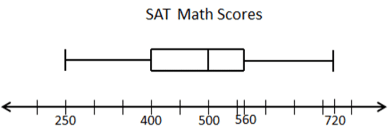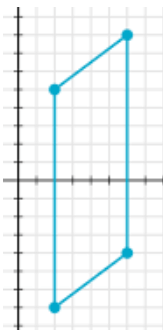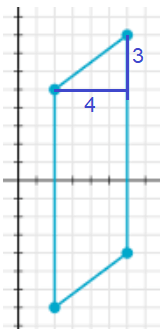EOC MATH 1 WORKSHEET WITH SOLUTIONS
Problem 1 :
For the given expression, (x - 1)(x - 3) - 5x, simplify to standard form ax2 + bx + c, what is a, b and c ?
Solution :
= (x - 1)(x - 3) - 5x
= x2 - 3x - x + 3 - 5x
= x2 - 4x - 5x + 3
= x2 - 9x + 3
Comparing with ax2 + bx + c
a = 1, b = -9 and c = 3
Problem 2 :
Given f(x) = x + 4, g(x) = x2 - 3x + 5 and h(x) = 3x + x
a) What is f(x) + g(x) ?
b) what is f(2) x g(2) ?
c) what is h(3) ?
Solution :
a) f(x) = x + 4, g(x) = x2 - 3x + 5
f(x) + g(x) = x + 4 + x2 - 3x + 5
= x2 - 2x + 9
b) f(2) x g(2)
f(2) = 2 + 4 ==> 6
g(2) = 22 - 3(2) + 5
= 4 - 6 + 5
= 9 - 6
= 3
f(2) x g(2) = 6 x 3 ==> 18
c) h(3) = 33 + 3
= 27 + 3
h(3) = 30
Problem 3 :
What is the vertex of x2 - 10x + 9 ? What quadrant is it in ?
Solution :
Vertex :
x - coordinate = -b/2a
a = 1, b = -10 and c = 9
x = -(-10)/2(1)
x = 10/2
x = 5
Applying the value of x in given quadratic function, we get
y = x2 - 10x + 9
y = 52 - 10(5) + 9
y = 25 - 50 + 9
y = -16
Vertex is (5, -16) and it lies in 4th quadrant.
Problem 4 :
Given the equations : y = 10(1.02)x and y = 2x + 10
a) What is the rate of the exponential function ?
b) What is the starting point of the exponential function ?
c) Is the exponential function growth or decay ? why ?
d) Which function is steeper ? and why ?
Solution :
y = 10(1.02)x
Expressing the given function in the form of
y = a(1+r%)x or y = a(1-r%)x
y = 10(1 + 2%)x
So, the given function is growth function
b) To find the starting point, we have to put x = 0
y = 10
c) Since the given function is expressed in the form of
y = a(1+r%)x
it is exponential growth function.
d) The first function is exponential and the second function is linear function. Always exponential function will be steeper then linear function.
Problem 5 :
What is the starting value in the equation y = 3(0.92)x ?
a) What is the rate ?
b) What is the starting point ?
c) Is it growth or decay, why ?
Solution :
a) y = 3(0.92)x
y = a(1-r%)x
1 - r% = 0.92
1 - 0.92 = r%
0.08 = r%
8% = r%
Rate is 8%.
b) To find starting point, we apply x = 0
y = 3
c) It is a decay function, the given function is in the form of
y = a(1-r%)x
Problem 6 :
a. Given the system 2x + 3y = 13 and x = 5y, what is x + y ?
b. Which quadrant does this solution lie ?
Solution :
2x + 3y = 13 -----(1)
x = 5y -----(2)
a)
Applying the value of x in the (1) equation
|
2(5y) + 3y = 13 10y + 3y = 13 13y = 13 y = 1 |
x = 5(1) x = 5 |
Solution is (5, 1).
b) The point (5, 1) lies in the 1st quadrant.
Problem 7 :
Given f(x) = x2 + 20x - 18 and g(x) = 20x + 18, what is the smallest solution to f(x) = g(x) ?
Solution :
f(x) = x2 + 20x - 18 and g(x) = 20x + 18
x2 + 20x - 18 = 20x + 18
x2 - 18 = 18
x2 = 36
x = ±6
Problem 8 :
Let y = 2x -10
a. If m is the x-intercept and n is the y-intercept, what is m - n?
b. If m is the x-intercept and n is the slope, what is m subtracted from n ?
Solution :
|
x-intercept : put y = 0 2x - 10 = 0 2x = 10 x = 5 m = 5 |
y-intercept : put x = 0 y = 2(0) - 10 y = -10 n = -10 |
a) m - n = 5 - (-10) ==> 15
b) m = 5, slope (n) = 2
n - m = 2 - 5 ==> -3
Problem 9 :
If f(x) = 3x - p and f(5) = 10, what is the value of p ?
Solution :
f(x) = 3x - p and f(5) = 10
f(5) = 3(5) - p
10 = 15 - p
p = 15 - 10
p = 5
Problem 10 :
Given ((x2)3)4 and the expression, xr what is r ?
Solution :
((x2)3)4 = x24
So, the value of r is 24.
Problem 11 :
Simplify
Solution :
Problem 12 :
Simplify x
Solution :
Problem 13 :
Given the box and whisker plot, what is IQR (interquartile range) and median.

Solution :
Inter quartile range = Q3 - Q1
= 560 - 400
= 160
Median = 500
Problem 14 :

a. What is the area of the parallelogram ?
b. What is the perimeter of the parallelogram ?
Solution :
a)
Base = 12, height = 4
Area of parallelogram = base x height
= 12 x 4
= 48 square units.
b) Length = 12
To find the width of the parallelogram, we use the picture given

Pythagorean theorem :
w2 = 42 + 32
w2 = 16 + 9
w = √25
width = 5
Perimeter of the parallelogram = 2(12 + 5)
= 2(17)
= 34 units
Problem 15 :
a. Does this set of points (1, 2) and (3, 4) make up a line parallel to y = 4 + 3x, why or why not ?
b. Tell the slope of the line perpendicular to y = 4 + 3x
Solution :
Slope of the line passes through the two points (1, 2) and (3, 4)
slope (m) = (4 - 2) / (3 - 1)
= 2/2
= 1
Slope of the given line :
m = 3
Since the slopes are not equal, the lines are not parallel.
b. The product of the slopes is not equal, they are not perpendicular.
Problem 16 :
What is the distance between the solutions for
f(x) = x2 + 14x + 49 and g(x) = 4x + 4 ?
Solution :
f(x) = x2 + 14x + 49
x2 + 14x + 49 = 0
(x + 7)(x + 7) = 0
x = -7 and -7
g(x) = 4x + 4
4x + 4 = 0
4x = -4
x = -1
Distance between -1 and -7 is 6.
Recent Articles
-
Finding Range of Values Inequality Problems
May 21, 24 08:51 PM
Finding Range of Values Inequality Problems -
Solving Two Step Inequality Word Problems
May 21, 24 08:51 AM
Solving Two Step Inequality Word Problems -
Exponential Function Context and Data Modeling
May 20, 24 10:45 PM
Exponential Function Context and Data Modeling